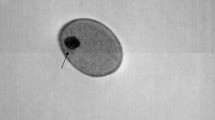Abstract
A Gram-negative, rod-shaped, salt-tolerant, non-pigmented, and non-spore-forming bacterium, designated strain W1T (type strain CICC 23797 = CGMCC1.14949), was isolated from sewage samples of a dairy farm in Bozhou, Anhui, China. Strain W1 was resistant to lincomycin, troleandomycin, rifamycin, and vancomycin. Sequence analysis of the 16S rDNA gene revealed that the strain showed sequence similarity of 98.2% with the closest related species Serratia quinivorans CP6aT. The genomic DNA G+C content of the isolate was 52.8 mol%. The biochemical characteristics of strain W1T assessed by the API 20E and Biolog GEN III analysis were different from those of the members of the genus Serratia. On the basis of the phenotypic and genotypic differences, strain W1 was proposed to be a novel Serratia species, Serratia bozhouensis sp. nov W1T.

Similar content being viewed by others
References
Ajithkumar B, Ajithkumar VP, Iriye R, Doi Y, Sakai T (2003) Spore-forming Serratia marcescens subsp. sakuensis subsp. nov., isolated from a domestic wastewater treatment tank. Int J Syst Evolut Microbiol 53(Pt 1):253–258
Altschul SF, Madden TL, Schaffer AA, Zhang J, Zhang Z, Miller W, Lipman DJ (1997) Gapped BLAST and PSI-BLAST: a new generation of protein database search programs. Nucleic Acids Res 25(17):3389–3402
And PADG, Grimont F (2006) The genus Serratia. Prokaryotes 1:219–244
Ashelford KE, Fry JC, Bailey MJ, Day MJ (2002) Characterization of Serratia isolates from soil, ecological implications and transfer of Serratia proteamaculans subsp. quinovora Grimont et al. 1983 to Serratia quinivorans corrig., sp. nov. Int J Syst Evolut Microbiol 52(Pt 6):2281–2289
Bhadra B, Roy P, Chakraborty R (2005) Serratia ureilytica sp. nov., a novel urea-utilizing species. Int J Syst Evolut Microbiol 55(Pt 5):2155–2158. doi:10.1099/ijs.0.63674-0
Brosius J, Palmer ML, Kennedy PJ, Noller HF (1978) Complete nucleotide sequence of a 16S ribosomal RNA gene from Escherichia coli. Proc Natl Acad Sci USA 75(10):4801–4805
Doi Y, Lee B-S, Iriye R, Tabata S, Tateishi K (1998) Dominantly growing bacteria in malodorless domestic sewage treatment tanks and their biochemical characteristics. J Antibact Antifung Agents (Japan) 26:53–63
Felsenstein J (1985) Confidence limits on phylogenies: an approach using the bootstrap. Evolution 39(4):783–791
Gavini F, Ferragut C, Izard D, Trinel PA, Leclerc H, Lefebvre B, Mossel DAA (1979) Serratia fonticola, a new species from water. Int J Syst Bacteriol 29(2):92–101. doi:10.1099/00207713-29-2-92
Geiger A, Fardeau ML, Falsen E, Ollivier B, Cuny G (2010) Serratia glossinae sp. nov., isolated from the midgut of the tsetse fly Glossina palpalis gambiensis. Int J Syst Bacteriol 60(Pt 6):1261–1265. doi:10.1099/ijs.0.013441-0
Gerber NN (1975) Prodigiosin-like pigments. CRC Crit Rev Microbiol 3(4):469–485
Gerhardt P, Murray RGE, Wood WA, Krieg NR (1994) Methods for general and molecular bacteriology. American Society for Microbiology, Washington, DC
Gevers D, Huys G, Swings J (2001) Applicability of rep-PCR fingerprinting for identification of Lactobacillus species. FEMS Microbiol Lett 205(1):31–36
Grimont F, Grimont PAD (1992) The genus Serratia. In: Balows A, Trüper HG, Dworkin M, Harder W, Schleifer KH (eds) The prokaryotes, vol. 3, 2nd edn. Springer, New York, pp 2822–2848
Grimont PD, Grimont F, Irino K (1982) Biochemical characterization of Serratia liquefaciens sensu stricto, Serratia proteamaculans, and Serratia grimesii sp. nov. Curr Microbiol 7(2):69–74. doi:10.1007/bf01568416
Grimont PD, Jackson TA, Ageron E, Noonan MJ (1988) Serratia entomophila sp. nov. associated with amber disease in the New Zealand grass grub Costelytra zealandica. Int J Syst Bacteriol 38(1):1–6. doi:10.1099/00207713-38-1-1
Gul M, Dogan E, Kirecci E, Ucmak H, Dirican E, Karadag A (2011) Serratia ficaria isolated from sputum specimen. Acta Microbiol Immunol Hung 58(3):235–238
Hearn WR, Elson MK, Williams RH, Medina-Castro J (1970) Prodigiosene [5-(2-pyrryl)-2,2-’-dipyrrylmethene] and some substituted prodigiosenes. J Org Chem 35(1):142–146
Mesbah M, Premachandran U, Whitman WB (1989) Precise measurement of the G+C content of deoxyribonucleic acid by high-performance liquid chromatography. Int J Syst Bacteriol 39(2):159–167. doi:10.1099/00207713-39-2-159
Saitou N, Nei M (1987) The neighbor-joining method: a new method for reconstructing phylogenetic trees. Mol Biol Evol 4(4):406–425
Smibert RM, Krieg NR (1994) Phenotypic characterization. In: Gerhardt P, Murray RGE, Wood WA, Krieg NR (eds) Methods for general and molecular bacteriology. American Society for Microbiology, Washington, DC, pp 607–654
Spröer C, Mendrock U, Swiderski J, Lang E, Stackebrandt E (1999) The phylogenetic position of Serratia, Buttiauxella and some other genera of the family Enterobacteriaceae. Int J Syst Bacteriol 49(4):1433–1438
Tamura K, Dudley J, Nei M, Kumar S (2007) MEGA4: molecular evolutionary genetics analysis (MEGA) software version 4.0. Mol Biol Evol 24(8):1596–1599. doi:10.1093/molbev/msm092
Zhang CX, Yang SY, Xu MX, Sun J, Liu H, Liu JR, Kan F, Lai R, Zhang KY (2009) Serratia nematodiphila sp. nov., associated symbiotically with the entomopathogenic nematode Heterorhabditidoides chongmingensis (Rhabditida: Rhabditidae). Int J Syst Evolut Microbiol 59(Pt 7):1603–1608. doi:10.1099/ijs.0.65718-0
Acknowledgements
This work was supported by the National Natural Science Foundation of China (Grants 31672571 and 31371324).
Author information
Authors and Affiliations
Corresponding author
Ethics declarations
Conflict of Interest
The authors declare that they have no conflict of interest.
Ethical Approval
This article does not contain any studies with human participants or animals performed by any of the authors.
Rights and permissions
About this article
Cite this article
Shang, F., Xue, T., Wang, M. et al. Serratia bozhouensis sp. nov., Isolated from Sewage Samples of a Dairy Farm. Curr Microbiol 74, 827–831 (2017). https://doi.org/10.1007/s00284-017-1253-7
Received:
Accepted:
Published:
Issue Date:
DOI: https://doi.org/10.1007/s00284-017-1253-7




